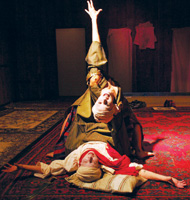home | metro silicon valley index | the arts | stage | review

Photograph by Carol Eckstein
Muse news: Barbara Geary (below) plays a 17th-century painter in 'Artemisia.'
Art Smart
Dell'Arte Company paints a compelling portrait in 'Artemisia'
By Marianne Messina
THE AGED BRICK wall surrounding the stage at Theater on San Pedro Square helps set the 17th-century tone for Artemisia, a rich production by the visiting Dell'Arte Company. At the front of the stage sits the white plume pen with which the main character, Italian Renaissance painter Artemisia Gentileschi, writes her letters (the plume is a possible reference to one of Gentileschi's self-portraits). Heaps of Persian rugs cover the stage; soft amber lighting approximates candle light. "The amber oil of Venice," Artemisia (Barbara Geary) instructs her model Giulia (Keight Gleason). "With it you can make light emerge from darkness."
And likewise, this production remains conscious of the alchemy of line, shape, light and movement. The lush rounded lines of the women's clothing, from head wraps to puffed sleeves and full skirts, evoke the era and a kind of rolling tempo. In slow, sweeping movements, Artemisia raises and lowers a horizontal canvas by its four-corner rigging. Pulled aloft, it acts as a bed; dropped to the floor, it makes a floor tarp.
San Francisco.com Real Estate
Moving to the Bay Area just became easy. Let San Francisco.com show you all the homes currently for sale.
San Jose.com Real Estate
Relocating to San Jose or Silicon Valley? Let San Jose.com introduce you to some expert area real estate agents.
In this visceral re-creation of the artistic life of Gentileschi, movement is as important as text and image. The movement is often down-tempo, as if taking place in another dimension (or perhaps era). Geary and Gleason are onstage together all the time, like the essence of the relationship in Artemisia's painting Judith and the Maidservant. As the model for Artemisia's Judith, the red-haired, muscular Gleason manages to seem both common and educated, presumptuous and bright. In the continual movement sometimes Artemisia takes center stage. As she reads from her journal or enacts the dream of her rape by her teacher Agostino Tassi, Giulia is huddled in the dark. In some scenes, they are naked. Sometimes the two move in concert, shadow essences of each other poured into a slow but powerful choreography. As they move, clever lighting casts haunting shadows over the stage.
Contemporary music, thin, percussive strings and harps with loose inchoate melody, directs the movement. In creating what is presumably director Giulio Cesare Perrone's idea of Gentileschi's mindscape, this "modern" musical conception works. It defines the angst and drive, the tortured inner tension. It also funnels the artist into the present. Yet as the only element that never calls up the period of Gentileschi's life, this music had me hoping for some reminder of Renaissance sublime, music of weight and liturgical moment like Monteverdi's Vespers of 1610.
Overall, the production is captivating. The story of Artemisia's traumatic adolescence and her career-long struggle to channel the monster (both the memory of and the forces unleashed by Agostino) shoots out in multiple modes like light from a prism—a narration, a dream, a dumb show, a dance between Artemisia and Giulia. It also relies on a mosaic of texts. Parts are written by Perrone and Geary, parts come from Artemisia's actual notes and from the Bible, and parts are transcripts from the trial, her father's lawsuit against Tassi (which led to Artemisia's torture by the court).
As the play gives context to Artemisia's work, especially the revisited subject of the Biblical Judith, Geary invests her Artemisia with a verge-of-madness quality and moves like chaos in oil. "I want to commit the immortal murder," she says of her bloody depiction of Judith beheading Holofernes. When she shifts back and forth between the 14-year-old Artemisia and her rapist Agostino, Geary's riveting performance drives home the degree to which Artemisia has internalized the voice of the nemesis. Geary often delivers speeches in a sort of sing-sing way, as a ghost, distanced from the emotional body. The result, combined with the amber lighting, is like a haunting. In something beyond story, the elements of this show bring Artemisia to life emanating from the stage as a rhythmical, visual entity.
Artemisia, a Dell'Arte Company presentation, plays Thursday-Sunday (Jan. 25-28) at 8pm at Theater on San Pedro Square, 29 N. San Pedro St., San Jose. Tickets are $15. (408.295.4416)
Send a letter to the editor about this story.
|
|
|
|
|
|
